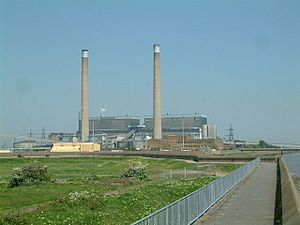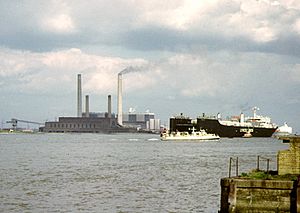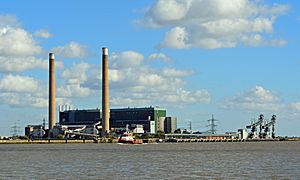Tilbury power stations facts for kids
Quick facts for kids Tilbury power stations |
|
|---|---|

Tilbury B Power Station
Viewed from the west in May 2008 |
|
| Country | England |
| Location | Tilbury |
| Coordinates | 51°27′18″N 0°23′30″E / 51.454926°N 0.391677°E |
| Status | Decommissioned and demolished |
| Construction began | A station: 1951 B station: 1961 |
| Commission date | A station: 1956 B station: 1968 |
| Decommission date | A station: 1981 B station: 2013 |
| Owner(s) | Central Electricity Authority (1955–1957) Central Electricity Generating Board (1958–1990) National Power (1990–2000) Innogy plc (2000–2002) npower (2002–2013) |
| Operator(s) | CEGB 1958-1990 |
| grid reference TQ661756 | |
The Tilbury power stations were two large thermal power stations located on the north bank of the River Thames in Tilbury, England. A thermal power station creates electricity by burning fuel to heat water and make steam.
The first one, called Tilbury A Power Station, used both coal and oil to make electricity. It could produce 360 megawatts (MW) of power. It started working in 1956 and closed down in 1981. It was later taken apart in 1999.
The second and much larger one was Tilbury B Power Station. It operated from 1968 to 2013 and could generate 1,428 MW. It mainly burned coal, but also used oil and, later, biomass (like wood pellets). Tilbury B was demolished between 2016 and 2019. Since 2013, new power stations have been planned or built in the Tilbury area.
Contents
History of Tilbury Power Stations
Building Tilbury A Station
Plans for Tilbury A power station began in 1947. After the electricity industry in the UK was taken over by the government in 1948 (this is called nationalisation), different government groups continued the plans.
Construction of Tilbury A started in 1951. It began making electricity in 1956. After running for 25 years, the station was closed down in 1981. Most of it was taken apart in 1999. The entire site was cleared by 2019 to make way for a new port called Tilbury2.
Building Tilbury B Station
The government's electricity board started building the much bigger Tilbury B station in 1961. This station began making electricity in 1968 and was working at full power by 1969.
When the electricity industry became private again in 1990, Tilbury B was owned by a company called National Power. Later, it was operated by RWE npower.
Changing to Biomass Fuel
In May 2011, RWE began changing Tilbury B to burn only biomass. Biomass is fuel made from plants, like wood pellets. They hoped this change would allow the station to make 750 MW of electricity from wood pellets. These pellets were brought in from places like Georgia, USA, and other parts of Europe.
This change made Tilbury B the largest power station in the world to use biomass as its only fuel. However, in July 2013, RWE npower stopped the conversion. It was too difficult and expensive to finish. The station was then closed down and later taken apart between 2016 and 2019.
Plans for Tilbury C Station
In 2007, npower announced plans for a new, "cleaner" coal-fired power station to replace Tilbury B. This new station, called Tilbury C, would have been very powerful, making 1,600 MW of electricity.
It was expected to cost £1 billion to build and be ready by 2014. However, RWE later put these plans on hold.
How the Stations Were Designed
Tilbury A Station's Design
Tilbury A was designed by expert engineers and architects. It was built on a large area of land, about 91.5 hectares. The buildings were made with a steel frame and covered with London stock brick.
The main parts, like the boiler house and turbine hall, had tall windows. Tilbury A had two tall concrete chimneys, each 100 metres high.
The station had six large machines called turbo-alternators, each making 60 MW of power. This gave it a total power output of 360 MW. It was built to burn coal, which arrived by boat at a special dock on the Thames. Later, it was changed to burn oil as well.
Water from the River Thames was used to cool the machinery. The power station was connected to the National Grid, which is the system that carries electricity all over the country.
In 1963, scientists used Tilbury A to study how pollution, like sulphur dioxide, spread from the chimneys. They found that pollution was highest a few kilometres away, depending on the wind.
Tilbury B Station's Design
Tilbury B was built on the land where coal used to be stored for Tilbury A. It was also a steel-framed building, but it had concrete panels instead of windows on its sides.
Tilbury B had four large power-generating units, each capable of making 350 MW. When all four were working, the station could produce 1,428 MW of electricity. This was enough power for about 1.4 million people, which is most of the population of Essex.
The station had two very tall concrete chimneys, each 168 metres high. Besides the main steam-powered generators, Tilbury B also had four smaller gas turbines. These were used to provide extra power during times of high demand.
In 1990, two large machines were added to the dock to unload coal from ships. The dock was made bigger in 2004 to handle ships carrying up to 65,000 tons of coal.
Electricity Production
Here's how much electricity Tilbury A and B stations produced each year from 1957 to 1987. The numbers are in GWh (gigawatt-hours), which is a way to measure a lot of electricity.
Tilbury A annual electricity output GWh.<graph>{ "version": 2, "width": 800, "height": 300, "data": [ { "name": "table", "values": [ { "x": 1964, "y": 1484 }, { "x": 1965, "y": 1522 }, { "x": 1966, "y": 1523 }, { "x": 1967, "y": 1730 }, { "x": 1968, "y": 1625 }, { "x": 1969, "y": 1736 }, { "x": 1970, "y": 2520 }, { "x": 1971, "y": 2662 }, { "x": 1972, "y": 2223 }, { "x": 1973, "y": 2113 }, { "x": 1974, "y": 1088 }, { "x": 1975, "y": 1022 }, { "x": 1976, "y": 462 }, { "x": 1977, "y": 315 }, { "x": 1978, "y": 493 }, { "x": 1979, "y": 441 }, { "x": 1980, "y": 153 }, { "x": 1981, "y": 35 }, { "x": 1982, "y": 0 }, { "x": 1983, "y": 0 }, { "x": 1984, "y": 0 }, { "x": 1961, "y": 2172 }, { "x": 1957, "y": 223 }, { "x": 1958, "y": 1250 }, { "x": 1960, "y": 2340 }, { "x": 1961, "y": 2256 }, { "x": 1962, "y": 2151 }, { "x": 1963, "y": 2307 } ] } ], "scales": [ { "name": "x", "type": "ordinal", "range": "width", "zero": false, "domain": { "data": "table", "field": "x" } }, { "name": "y", "type": "linear", "range": "height", "nice": true, "domain": { "data": "table", "field": "y" } } ], "axes": [ { "type": "x", "scale": "x" }, { "type": "y", "scale": "y" } ], "marks": [ { "type": "rect", "from": { "data": "table" }, "properties": { "enter": { "x": { "scale": "x", "field": "x" }, "y": { "scale": "y", "field": "y" }, "y2": { "scale": "y", "value": 0 }, "fill": { "value": "steelblue" }, "width": { "scale": "x", "band": "true", "offset": -1 } } } } ] }</graph>Tilbury B annual electricity output GWh.<graph>{ "version": 2, "width": 800, "height": 300, "data": [ { "name": "table", "values": [ { "x": 1964, "y": 0 }, { "x": 1965, "y": 0 }, { "x": 1966, "y": 23 }, { "x": 1967, "y": 26 }, { "x": 1968, "y": 27 }, { "x": 1969, "y": 70 }, { "x": 1970, "y": 1035 }, { "x": 1971, "y": 1385 }, { "x": 1972, "y": 1617 }, { "x": 1973, "y": 1736 }, { "x": 1974, "y": 3115 }, { "x": 1975, "y": 3402 }, { "x": 1976, "y": 4587 }, { "x": 1977, "y": 4217 }, { "x": 1978, "y": 2123 }, { "x": 1979, "y": 2930 }, { "x": 1980, "y": 3742 }, { "x": 1981, "y": 3712 }, { "x": 1982, "y": 4868 }, { "x": 1983, "y": 4821 }, { "x": 1984, "y": 4691 }, { "x": 1987, "y": 3523 } ] } ], "scales": [ { "name": "x", "type": "ordinal", "range": "width", "zero": false, "domain": { "data": "table", "field": "x" } }, { "name": "y", "type": "linear", "range": "height", "nice": true, "domain": { "data": "table", "field": "y" } } ], "axes": [ { "type": "x", "scale": "x" }, { "type": "y", "scale": "y" } ], "marks": [ { "type": "rect", "from": { "data": "table" }, "properties": { "enter": { "x": { "scale": "x", "field": "x" }, "y": { "scale": "y", "field": "y" }, "y2": { "scale": "y", "value": 0 }, "fill": { "value": "steelblue" }, "width": { "scale": "x", "band": "true", "offset": -1 } } } } ] }</graph> The main steam generators of Tilbury B station only started working in 1968. Any electricity made by Tilbury B before this date came from its smaller gas turbines.
The A station was able to turn 30.84% of its fuel's energy into electricity. The B station was a bit more efficient, turning 32.19% of its fuel's energy into electricity.
Incidents at the Power Station
1977 Fire Incident
In the early morning of November 16, 1977, a fire started at Tilbury B. It began in the control room and spread through the building. The site was evacuated, and three engineers who stayed to shut down the plant were taken to the hospital for breathing in smoke. Firefighters from other power stations helped put out the fire.
2008 Boiler Incident
On July 1, 2008, an engineer working on a boiler fell about 20 feet (6 metres) inside it. Rescue crews used an internal staircase to help him out.
2009 Fire Incident
Another fire broke out at the power station on July 29, 2009. This happened when one of the high-pressure turbine units failed. Workers were quickly evacuated, and the fire was brought under control within a few hours. No one was hurt in this incident.
2012 Fire Incident
A major fire started in a fuel storage area of the station on the morning of February 27, 2012. Over 120 firefighters were called to the scene. The fire involved a large amount of fuel, between 4,000 and 6,000 tonnes, stored in big cells. Two of these cells were burning strongly.
Firefighting was difficult because the fire was high up in the main building, which was also filled with smoke. Firefighters used special equipment, including aerial ladder platforms and a helicopter with a thermal-imaging camera. Support teams from the London Fire Brigade also helped.
Another fire that started nearby in the Tilbury docks at the same time was not connected to the power station fire. It took firefighters many hours to control the power station blaze. Crews stayed for days afterward to make sure all embers were out.
Demolition of Chimneys and Station
The tall chimneys of the B station were taken down on September 28, 2017. The 14th and final explosive demolition at the site happened in March 2019, completing the removal of the power station.
Ash Disposal Site
When coal is burned at a power station, it produces ash. This ash from the Tilbury power station was placed on low-lying marshland to the east of the site. This area, called Goshems Farm, had also been used for other waste over the years.
In 2003, a plan was started to fix up this land. The idea was to raise the height of the land using soil from other building projects along the River Thames. Then, the land would be turned back into good farmland. Large amounts of building material are brought by barges to the farm's wharf. This restoration work is still ongoing. A public walking path will also be created along the riverside.
Other Power Stations in Tilbury
Besides the old Tilbury A and B stations, there are three other power stations in Tilbury that have been planned or are now working.
Tilbury Energy Centre
The Tilbury Energy Centre is a planned power station that will use natural gas. It will be a Combined Cycle Gas Turbine (CCGT) plant, which means it uses gas turbines and then uses the waste heat to make more electricity with steam turbines. It will also have a "peaking plant" (for quick power when needed) and a large battery storage unit.
This centre will be built on the site where Tilbury B power station used to be. It is planned to have three gas-fired units, making a total of 2500 MW. It will also have a 300 MW peaking plant and batteries that can store 100 MW of electricity. The centre could also provide heat for buildings and be ready for carbon capture technology in the future.
The chimneys for the main gas units will be 95 metres tall, and the peaking plant chimneys will be 45 metres tall. In 2018, plans for the Tilbury Energy Centre were put on hold.
Thurrock Flexible Generation Plant
The Thurrock Flexible Generation Plant is another planned facility that will use natural gas engines and large batteries to produce electricity. It will be located just north of the old Tilbury power station site.
This plant will have up to 60 fast-starting gas engines. These engines will be connected to generators that can produce a total of 600 MW of electricity. In addition, large batteries will be able to store up to 600 MWh of energy and release up to 150 MW of electricity.
The engines will not run all the time. They will start up for short periods, several times a day, when the National Grid needs extra power. They are expected to run for less than half the year. The chimneys from the engines might be grouped together and will be 40 metres tall.
Work on this plant is expected to start in 2020, with main construction beginning in 2021. The plant is designed to operate for 35 years.
Tilbury Green Power
The Tilbury Green Power plant is a power station that is already working. It uses wood as its fuel source. This plant is located inside the Port of Tilbury.
There were two phases planned for this project. Phase 1 is a 40 MW power plant that burns waste wood. Phase 2 was planned to be a 20 MW plant using Solid Recovered Fuel (SRF), but only Phase 1 has been built so far. Construction started in August 2015, and the plant began making electricity in early 2019.
The plant uses about 270,000 tonnes of waste wood each year. This wood is processed into wood-chips on site and then burned in a special boiler. The steam produced by the boiler spins a steam turbine to generate electricity. The electricity is sent to the National Grid through an underground cable.
The gases from burning the wood are cleaned using special technology before they are released into the air through a 100-metre-high chimney.




